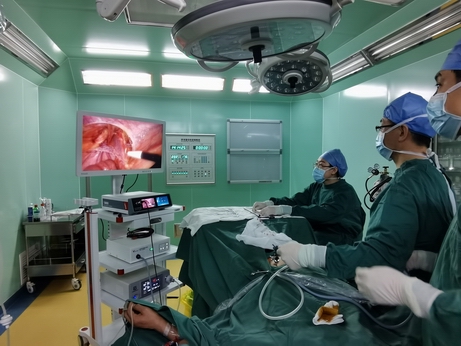Laparoscopic Camera for Surgery: Enhancing Precision and Safety
Laparoscopic surgery has revolutionized the field of surgery by providing minimally invasive procedures that lead to faster recovery and reduced scarring for patients. This technique utilizes a laparoscope, a device that contains a camera and light source, which allows surgeons to view the internal organs on a monitor while performing the procedure through small incisions. The laparoscopic camera is an essential component of this technique, enabling surgeons to see the internal organs and tissues clearly and perform precise movements with surgical instruments. In this essay, we will discuss the importance of the laparoscopic camera in surgery and how it enhances precision and safety for patients.

The laparoscopic camera is an advanced medical device that has transformed the way surgeons approach surgery. It is a small camera that is inserted into the body through a small incision and provides a high-quality video feed of the internal organs on a monitor. The camera is attached to a long, thin, flexible tube called a laparoscope, which is inserted into the body cavity. The laparoscope is designed to be maneuvered easily, providing a clear view of the area being operated on.
One of the main benefits of laparoscopic surgery is that it offers a much clearer view of the internal organs than traditional open surgery. The laparoscopic camera provides a high-resolution image of the surgical site, enabling surgeons to see the smallest details and make precise movements. The camera also offers a 3D view of the surgical site, which enhances depth perception and makes it easier for the surgeon to navigate around organs and tissues. This improved visibility allows the surgeon to perform more complex procedures with greater accuracy and confidence.
Another advantage of the laparoscopic camera is that it reduces the risk of complications and improves patient safety. The camera allows the surgeon to make smaller incisions, which reduces the amount of trauma to the surrounding tissue and results in less blood loss. This reduces the risk of infection and other post-operative complications, allowing patients to recover more quickly and with less pain. Additionally, the laparoscopic camera enables the surgeon to see the surgical site clearly and avoid damaging nearby organs or tissues, which can result in serious complications.
In conclusion, the laparoscopic camera is a critical component of laparoscopic surgery, allowing surgeons to perform procedures with greater precision and safety. The camera provides a high-resolution image of the internal organs and tissues, which enhances the surgeon's visibility and enables them to make precise movements. Furthermore, it reduces the risk of complications and improves patient outcomes by allowing for smaller incisions and reducing trauma to surrounding tissue. As technology continues to advance, the laparoscopic camera will undoubtedly continue to play a vital role in enhancing surgical procedures and improving patient care.



Leave a message